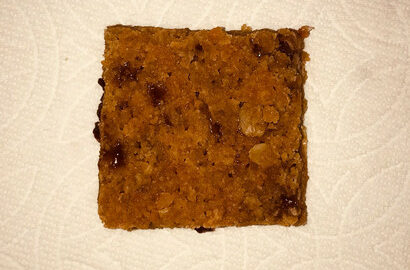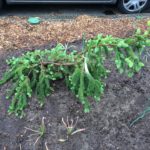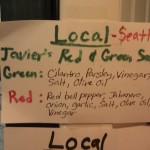It’s summer, which means ginger beer! Or, I guess, force-carbonated ginger lemonade.
The batch I just made had these proportions:
- 160g lemon juice
- 150g ginger juice
- 250g cayenne simple syrup
- 1000g water
The cayenne simple syrup was made with 1 cup each of sugar and water, and 1 teaspoon of cayenne. It has a bit of heat right now; we’ll see if it gets hotter as it sits. If so, maybe cut that back to 1/2 a teaspoon, because I think where it is right now is good.
We originally set out to clone Rachel’s Ginger Beer, but our test batches kept tasting not ginger-y enough, and I haven’t had a reference taste of RGB recently. I’d be willing to bet that even without the cayenne, this has more of a kick now, though.
The recipe we started with called for 1 part ginger, 2 parts lemon, 3 parts simple syrup, and 10 parts water. After a bunch of experimentation, we seem to like it with roughly equal lemon and ginger, and a bit less sugar. The cayenne is a new experiment with this batch, based on really liking Columbia Gorge’s Meyer Ginger Lemonade, which has some cayenne in it. We’ll see if that’s worth keeping or not.
A note on carbonation: I’m carbonating this with a rig I put together myself after I’d crunched the numbers on whether it made more sense to buy a SodaStream or put together a carbonation rig from the homebrew supply shop. Here’s what I wrote about it at the time:
“Basic ball-lock keg kit (regulator, gas hose, beer hose with party faucet, fittings): $55. New aluminum 5-lb CO2 tank: $65. Carbonation cap for PET bottles: $15. Shipping: $8. Fill-up of CO2 tank at local fire extinguisher supply house: $15. Total cost: $158. (And I have some extra parts that I can use to tap a corny keg should one of my homebrewing friends bring me one of his batches.)
The cheapest basic sodastream starter kit runs around $85, so up front, I’m down $73. (That’s the lowest-end sodastream kit’s online price, mind you, not including shipping or tax. Buying one of the higher-end models at retail, I might be breaking even already.)
A 60L sodastream tank holds 14.5oz of CO2. So one refill of the 5lb tank is equivalent to 5.5 sodastream tanks. Each 14.5oz tank exchange costs $15, and I’ll need 4.5 more of those to match the amount of CO2 in my tank. That’s $67.50, so by the time I need a refill of my tank, I’ll only be down $9.50.
By the time I’ve gone through my second tank of C02, I’ll have spent another $15. If I had gone with sodastream, I would have needed another 5.5 tank exchanges, or $82.50. At this point, I’ll be ahead $58. Every time after this that I fill my tank, I’ll be ahead by another $67.50.
And that’s ignoring the fact that there’s nearly 10% local sales tax on the sodastream tank exchange, while the $15 refill of my 5lb tank includes tax. It also ignores the fact that sodastream bottles (the ones the soda goes in, and which need to be replaced periodically) cost $10 each, while reused 2L or 1L bottles are essentially free for me.”









